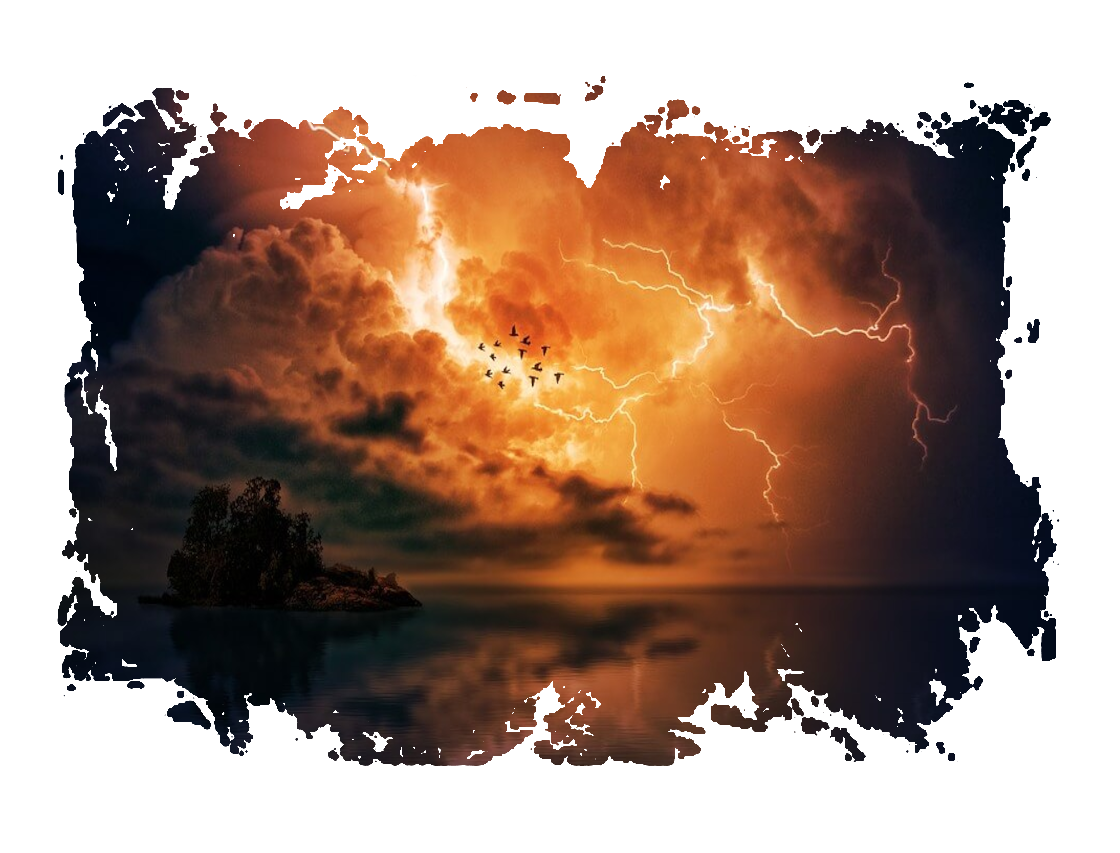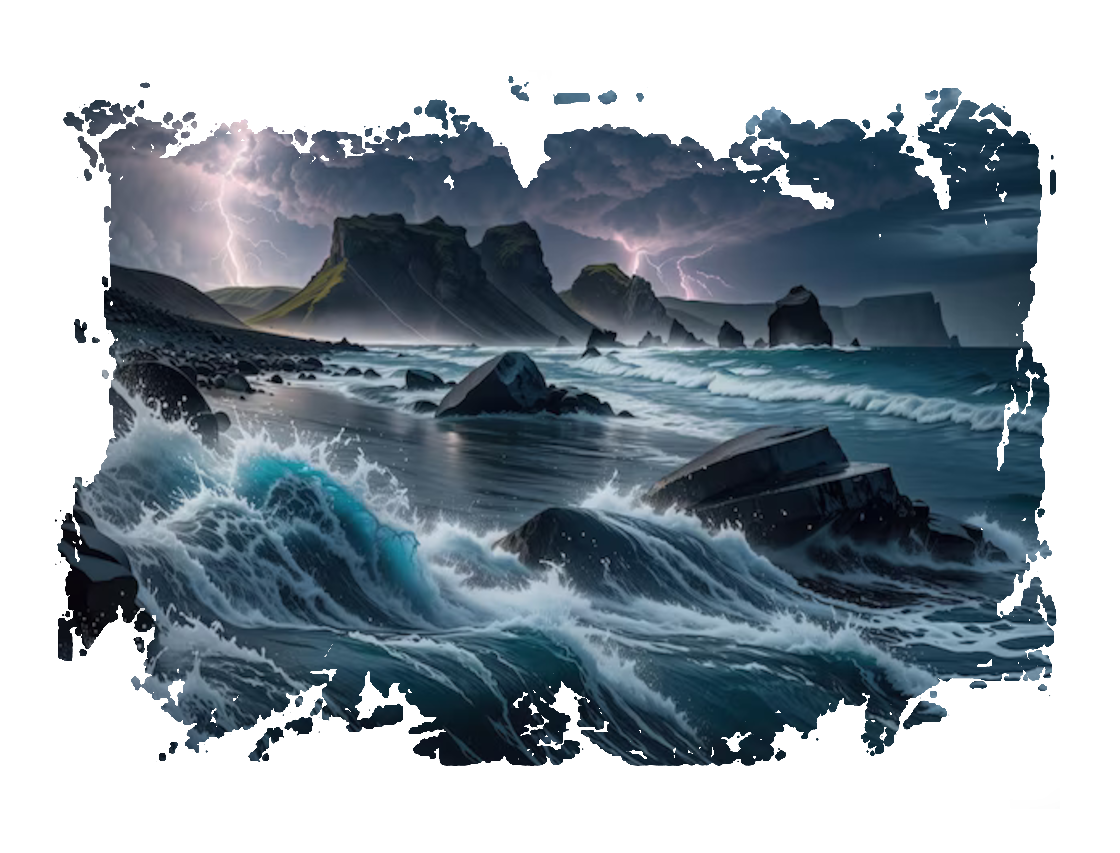
The Lightning Region - Lindin
in Yunan's World AtlasCall of the Storm
"As the tempestuous waves thrashed against the weather-beaten vessel, John found himself ensnared in the heart of a raging lightning storm out at sea. The heavens unleashed their fury with bolts of electricity, illuminating the tumultuous waters with an eerie glow. Each crack of thunder resonated through the very core of his being, reverberating with a primal force that instilled both awe and dread. Amidst the chaos, John struggled to maintain his footing, his senses overwhelmed by the ferocity of nature's wrath. With each flash of lightning, he glimpsed the towering waves that threatened to swallow him whole, their frothy crests looming like specters in the darkness. But what truly caught his attention, were the strange slender shapes silhouetted in the clouds, flying effortlessly amidst the maelstrom. They were ships." - Excerpt from Yunan's Guide to the RealmRegion Info
Alternative NamesThe Lightning Region, Lindin, The Maelstrom, The Herald
Ruling Kingdom
Linnel
Major Languages
Common, Tengu
Prominent Demographics
Humans, Tengu
Overview
Lindin is a dark, stormy land that hasn't seen sunlight in millennia. Constantly shrouded in clouds, it endures relentless storms with only brief respites of calm. Life here mirrors the chaos of its skies, with animals, plants, and people adapting to its volatile nature. Lightning strikes unpredictably, rain and sleet come and go in bursts, and high winds thrash the seas against rocky coasts.Despite the turmoil, life thrives. The people of Linnel and neighboring civilizations face the storms with ingenuity and determination, their ambition driving them to adapt and endure. Lindin is divided into two main regions: the rocky islands and shores, and the mainland peninsula with steep inclines and towering mountains that vanish into the storm clouds, leading toward Astana and Eiri.
Above it all floats Dinnel, or "High Land," the kingdom's crowning achievement—a massive chunk of earth suspended in the sky, home to Linnel's capital city and a testament to its resilience.
Climate
Lindin's climate is dominated by its storm systems. Though the area has the landform trends of a tropical region, full of sea-level land, islands, and the like, its largest landform, the Lindin Peninsula, is a stark continental region dominated by stark mountain ranges. Across the board, though, people within the area can expect high moisture levels, with warm, humid summers and mild, wet winters. The cloud coverage keeps the lands and anywhere close to ground level fairly cool all year round as heat rises and lingers higher in the air, churning with the storms to cause high winds and precipitation.Natural Resources
Linnel possesses a unique natural resource: the ability to harness lightning energy. Through advanced engineering and patented technology, Linnel captures and stores this energy in "power cells," integrating it into their infrastructure to supplement or replace conventional energy sources.Beyond this innovation, Linnel primarily trades its resources domestically, with limited external dealings due to strict trade policies. The region's rich coasts support deep-sea fishing, yielding crustaceans like crabs and lobsters. Its fertile, moisture-rich lands are ideal for cultivating water-based crops such as rice, lettuce, spinach, tomatoes, and beans. Additionally, Linnel excels in producing high-quality barley, wheat, and peat, fueling its renowned whiskey and other alcoholic beverage industries.
Society
The Lindin Peninsula is dotted with towns, many nestled at the mountain base or along the coast with port extensions. Life here is peaceful but rarely quiet, with constant thunder rolling through the skies. Over the past decade, war has significantly shaped the peninsula, driving industry and cultural shifts.Farming towns fill massive storehouses with grains and crops, distributing goods for profit. Linnel towns are well-built, featuring efficient architecture equipped with lightning rods to handle frequent storms. Lindin's history, especially in garnering independence from Astana, multiple civil wars, and Shamos's war happening today, all influences its culture. It ends up blending war-worn resilience with inventive craftsmanship. Cities thrive on skilled artisans crafting firearms, electric generators, and essential infrastructure for guilds and the government.
The war effort demands sacrifices, with farms and crafters contributing goods in exchange for bonds and royal acknowledgment. Military service is expected from most citizens, including historically oppressed minorities. Controversially, forced conscription targets groups like the tengu, defleo, and jotun, who also form the bulk of Lindin's impoverished population, sparking tension both within and beyond its borders.
Meanwhile, the tengu clans that still retain their freedom and lives live high up in the peaks of the penninsula's mountains, living in unreachable sanctuaries only accessible by those with the ability to fly or scal it's sheer cliffs.
World Codex
Story & Moderation Team: ames, capolock, foxhound99, skarra365, 1800HOTBEEF, Nekobot
Community Manager: staratly
Website Manager: foxhound99, skarra365
Community Manager: staratly
Website Manager: foxhound99, skarra365




